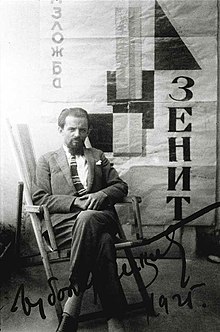Zenitism

Zenitism (Serbo-Croatian: Zenitizam / Зенитизам) was an avant-garde art movement in Yugoslavia that lasted from 1921 until 1926, first appearing in Zagreb from 1921 to 1924 and from 1924 in Belgrade.[1] It primarily involved visual arts, graphic design, poetry, literature, theatre, film, architecture and music.[2] Like other avant-garde movements at the time, it held anti-war, anti-bourgeois and anti-nationalist views and rejected traditional culture and art. Micić defined it as "abstract metacosmic expressionism."
The movement

Ljubomir Micić, a Serbian socialist, established the movement following World War I, during which Kingdom of Serbia lost a million inhabitants prior to creating Kingdom of Yugoslavia.[3]
In June 1921, he proclaimed the "Zenitist manifesto". Although some artists from the region were known in Europe, Zenitism was the first notable art movement from the Balkans in Europe.
Zenit magazine
Most of its artistic ideas were communicated through the Zenit magazine which Ljubomir Micić launched and which published 43 issues between 1921 and 1926. The magazine soon became famous internationally and saw many famous artists contributing the magazine. Most famous amongst them are Sergei Yesenin, Alexander Blok, Wassily Kandinsky, Boris Pasternak and Miloš Crnjanski.
The authors shared their radical views of the European civilisation and art. The movement would soon conflict and distance from Dada movement and Expressionism.
Political views
The movement was avant-garde socialist, anti-traditionist, anti-militarist with the focus on human. Micić himself believed in the imminent collapse of western Europe and the rise of "barbarogenie" - barbaric Balkan man who will take its place.
Barbarogenie was capable of recovering Europe using his barbaric strength of a man from the Balkans, unsoiled by the legacy of European civilization which collapsed after WW1.
The concept is arguably expressing signs of nationalism. In reality Micić, an ethnic Serb, initially expressed anti-Serbian sentiment. In the eve of World War II, Micić changed his worldview, now expressing Serbian nationalism. He created the new magazine where he proclaimed the "Serbianhood manifest", promoting Serbian integralism and unitarism, and Serbia as the unifying center of all Serbs.
References
- ^ Dragiša Živković (1971). Živan Milisavac (ed.). Jugoslovenski književni leksikon [Yugoslav Literary Lexicon] (in Serbo-Croatian). Novi Sad (SAP Vojvodina, SR Serbia): Matica srpska. p. 586.
- ^ "ЗЕНИТ - ZENIT". digital.nb.rs. Archived from the original on 2010-06-12.
- ^ Erlikman, Vadim (2004). Poteri narodonaseleniia v XX veke : spravochnik. Moscow. ISBN 5-93165-107-1.
External links
- Zenit at Monoskop.org.
- v
- t
- e
(Western)
| Ancient | |
|---|---|
| Medieval | |
| Renaissance | |
| 17th century |
|
| 18th century | |
| Colonial art | |
| Art borrowing Western elements |
|
| Transition to modern (c. 1770–1862) |
|
(1863–1944)
and Postmodern
(1945–present)
- History of art
- Abstract art
- Anti-art
- Avant-garde
- Ballets Russes
- Christian art
- Digital art
- Fantastic art
- Folk art
- Hierarchy of genres
- Illuminated manuscript
- Illustration
- Interactive art
- Jewish art
- Kitsch
- Landscape painting
- Modernism
- Naïve art
- Outsider art
- Portrait
- Prehistoric European art
- Queer art
- Realism
- Shock art
- Trompe-l'œil
- Western painting
 Category
Category
 | This aesthetics-related article is a stub. You can help Wikipedia by expanding it. |
- v
- t
- e
 | This article about a literary movement is a stub. You can help Wikipedia by expanding it. |
- v
- t
- e












